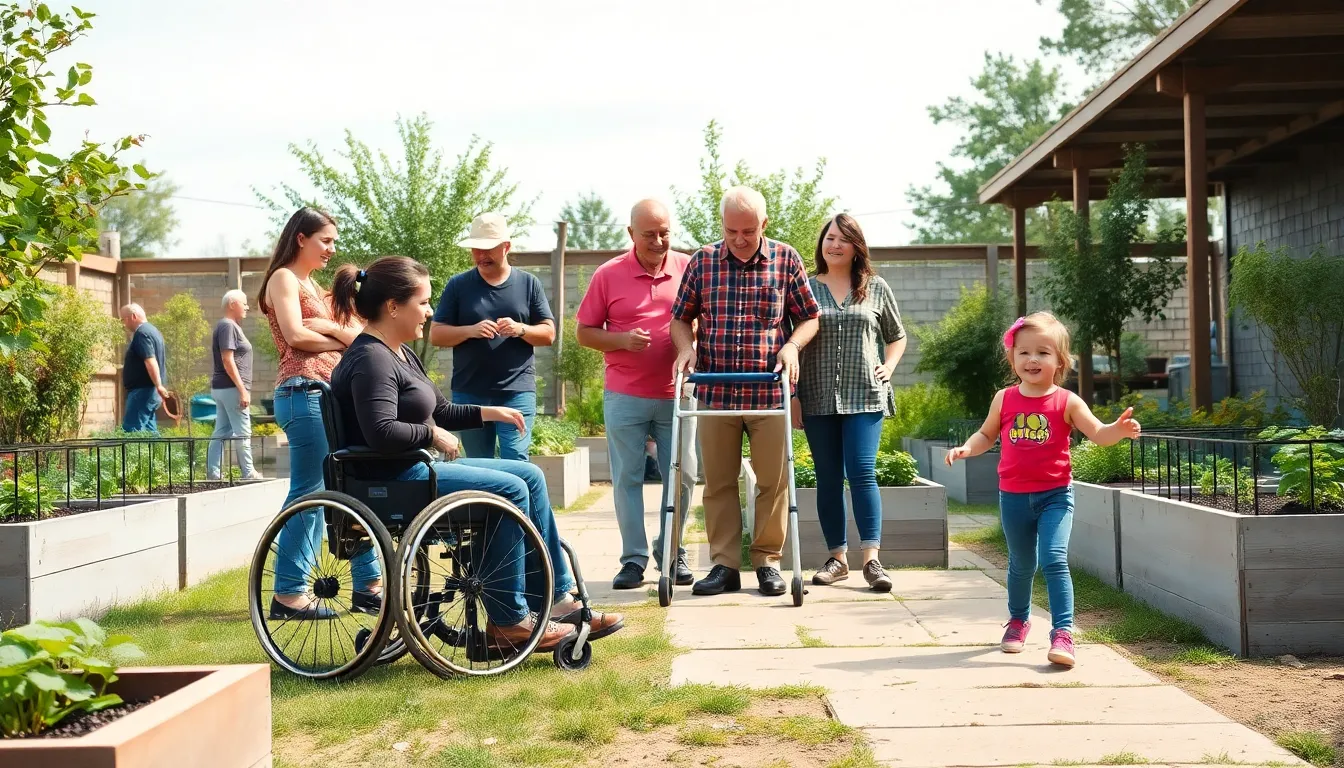Table of Contents
ToggleInclusive home design is more than just a trend; it’s a necessity for creating spaces that cater to everyone. As society becomes increasingly diverse, the demand for homes that accommodate various needs and abilities grows. This approach ensures that all individuals, regardless of age or physical capability, can navigate and enjoy their living environments.
By integrating accessibility features with aesthetic appeal, inclusive design fosters a sense of belonging and comfort. It encourages architects and homeowners alike to rethink traditional layouts and embrace innovative solutions. From wider doorways to adjustable countertops, every detail matters in crafting a home that truly welcomes all. Embracing inclusive design not only enhances functionality but also enriches the overall quality of life for residents and guests.
Understanding Inclusive Home Design
Inclusive home design creates spaces that accommodate diverse needs and abilities. It emphasizes accessibility while maintaining aesthetic value, fostering a sense of belonging.
Definition and Importance
Inclusive home design refers to creating living environments that everyone can access and utilize comfortably. The importance of this design lies in its ability to enhance the quality of life for individuals of various ages and abilities. By prioritizing accessibility, inclusive design reduces the risk of exclusion and promotes independence, making homes welcoming and functional for all.
Key Principles of Inclusivity
- Accessibility: Incorporating features like ramps, wide doorways, and no-step entries allows easy navigation for individuals with mobility challenges.
- Flexibility: Designing adaptable spaces, such as adjustable countertops and movable partitions, accommodates changing needs over time.
- Safety: Using slip-resistant flooring and appropriate lighting minimizes hazards and supports individuals’ protection within their homes.
- Universal Design: Applying principles that serve everyone regardless of age or ability ensures that all users experience equal functionality in their spaces.
- Comfort: Selecting ergonomic furniture and thoughtful layouts enhances usability and promotes relaxation in various living environments.
Benefits of Inclusive Home Design

Inclusive home design offers substantial benefits by creating environments accessible to everyone, regardless of age or ability. By prioritizing accessibility and community, these designs enhance the living experience for residents and their visitors.
Enhancing Accessibility
Inclusive home design enhances accessibility through thoughtful features that cater to diverse needs. Wider doorways facilitate movement for wheelchairs and mobility aids. Zero-step entries eliminate barriers, allowing easy access for all individuals. Adjustable countertops accommodate users of varying heights, promoting independence in daily activities. Additionally, incorporating slip-resistant flooring significantly reduces the risk of falls, ensuring safety throughout the home. By prioritizing these features, inclusive design allows individuals with disabilities to participate fully in daily life.
Fostering Community
Inclusive home design fosters a sense of community by creating spaces where everyone feels welcomed and valued. Common areas that are accessible encourage interaction between neighbors, promoting social engagement. Shared amenities like gardens or playgrounds designed with inclusivity in mind allow families of all backgrounds to connect. By prioritizing community spaces that accommodate diverse abilities, inclusive designs nurture relationships and strengthen social bonds among residents. Through these initiatives, individuals experience a heightened sense of belonging in their neighborhoods.
Elements of Inclusive Home Design
Inclusive home design incorporates specific elements to ensure accessibility and comfort for all individuals. Key areas of focus include architectural features and interior design considerations that cater to diverse needs.
Architectural Features
- Zero-step Entries: Provide seamless access, eliminating barriers at entrances.
- Wide Doorways: Accommodate wheelchairs and mobility devices, enhancing navigation.
- Ramps: Offer essential alternatives to stairs, broaden access for everyone.
- Lever Door Handles: Simplify operation compared to traditional knobs, increasing usability.
- Accessible Bathrooms: Incorporate features like grab bars and roll-in showers for safety.
- Adjustable Fixtures: Utilize elements like countertops and shelves, offering height adaptability.
Interior Design Considerations
- Ergonomic Furniture: Select furniture that promotes comfort and supports various physical needs.
- Flexible Layouts: Design open spaces that allow for easy movement and furniture rearrangement.
- Slip-resistant Flooring: Ensure safety with materials that reduce the risk of falls in high-traffic areas.
- Natural Lighting: Maximize sunlight to create bright, welcoming environments that reduce reliance on artificial lighting.
- Visual Contrast: Utilize colors and textures to assist those with visual impairments in distinguishing spaces and surfaces.
- Acoustic Treatments: Incorporate sound-absorbing materials to minimize noise and create a calming atmosphere.
Challenges in Implementing Inclusive Home Design
Implementing inclusive home design poses several challenges that architects and homeowners must navigate. Key issues include cost implications and overcoming resistance to change.
Cost Implications
Cost considerations represent a significant challenge in inclusive home design. Upfront expenses can be higher due to the incorporation of specialized materials and features, such as ramps, wider doorways, and adjustable fixtures. Budget constraints often deter homeowners from pursuing these designs. For instance, modifying existing homes typically requires additional financial investment. An analysis by the National Association of Home Builders indicates that adding accessibility features can increase renovation costs by approximately 10% to 25%. Despite these initial costs, inclusive design can yield long-term savings by reducing future modifications and enhancing property value.
Overcoming Resistance to Change
Resistance to change remains a prevalent challenge in adopting inclusive home design. Homeowners and builders may hold misconceptions about accessibility features, often associating them solely with institutional environments rather than residential spaces. Educating stakeholders about the benefits of inclusive design proves essential. Engaging communities through workshops can foster understanding and acceptance. By highlighting examples of aesthetically pleasing, inclusive homes, professionals can showcase design solutions that blend functionality with style. Demonstrating the positive impact on community dynamics can also encourage acceptance, ultimately leading to more informed decisions about inclusive living spaces.
Embracing inclusive home design is essential for creating spaces that cater to everyone. By prioritizing accessibility and comfort, homeowners can foster environments where individuals thrive regardless of their abilities. The thoughtful integration of architectural features and design elements not only enhances daily living but also nurtures community connections.
While challenges like costs and resistance to change exist, the long-term benefits far outweigh these hurdles. Investing in inclusive design leads to improved property value and enriches the quality of life for all residents. As awareness grows and innovative solutions emerge, inclusive home design will continue to shape welcoming and functional living spaces that truly reflect the diverse needs of society.


